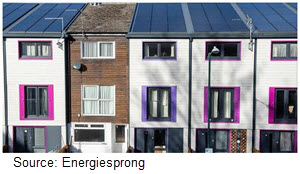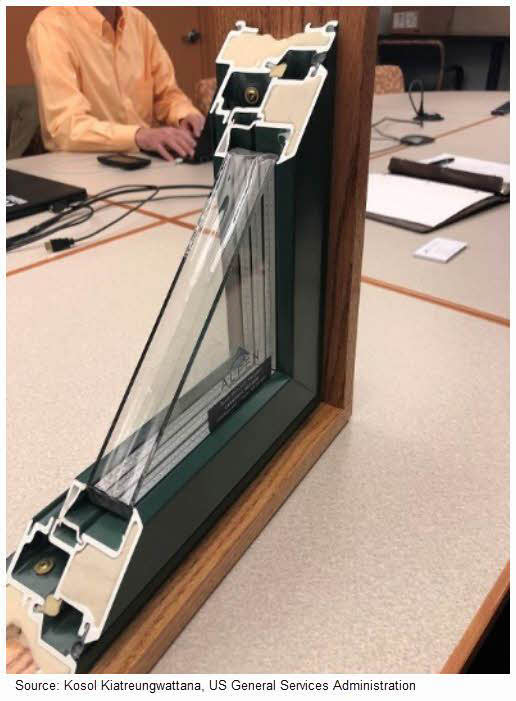
Held twice a year, our tech roundup webinars keep members of the E Source Technology Assessment Service updated on the latest developments in efficiency, load management, and decarbonization technologies.
During these online events, we present the top technologies and concepts our researchers have been following over the past six months that offer potential for utility pilots and programs.
We recently discussed 10 technologies and concepts we see on the horizon as part of our January 2022 tech roundup event. Here’s a glimpse at 3 that made the list.
Prefabricated exterior energy retrofits: A huge, untapped residential savings opportunity?
Prefabricated exterior energy retrofits (PEER) are prefabricated panels that you add to the outside of existing exterior walls and ceilings of homes to greatly enhance thermal performance. In Europe, PEERs are quickly becoming an important technology for enabling deep energy retrofits of existing building stock, demonstrating great energy savings potential. PEERs are often sold alongside comprehensive HVAC and roof-top solar upgrades. But we’ve only seen a small handful of demonstration sites and pilots for this promising approach in the US and Canada.
A home awaiting upgrades

Their high demonstrated savings potential, cost-effectiveness for low-rise multifamily housing, and alignment with utility programs for low- and moderate-income (LMI) customers, make PEERs one of the most promising emerging savings opportunities for utility pilots. Benefits of PEERs demonstrated in early US and Canadian pilots include:
- Building energy savings of 60% to 80% when paired with complementary HVAC and building measures
- Partial or full elimination of customer energy bills in low-rise multifamily housing when paired with rooftop solar and HVAC measures
- Low panel costs—$7 to $16 per square foot
- Alignment with utility LMI programs in that these customers are overrepresented in multifamily housing and building-shell quality tends to be lower for disadvantaged customers
- An increase in R-value of 10 to 20 points
- An increase of more that 80% in airtightness and normalized leakage area
- A decreas of more than 70% in thermal energy demand intensity and wall heat loss
Despite impressive savings potential in early pilots, the market for PEERs in the US and Canada is nascent. Utility pilot goals should focus on:
- Further establishing costs, savings, and installation processes
- Building case studies for demonstrating performance metrics to homeowners
- Establishing strategies for addressing limited panel manufacturing capabilities and contractor and inspector knowledge
Active managed EV charging: Is it right for you?
Compared to passive time-of-use or behavioral EV charging programs, active managed charging allows utilities to take control of EV charging loads. These programs come in different flavors—from bring-your-own-charger programs that slow charging demand during peak events to programs that cover installation costs for purchasing preprogrammed chargers from the utility. According to the Smart Electric Power Alliance’s State of Managed Charging in 2021 report, 29 utility programs exist with active control through EV supply equipment, up from 17 in 2019.
As more utilities launch active managed charging programs, evaluation reports are revealing interesting insights:
- Wide variances in EV charger availability and connectivity during peak events is leading to challenges for proving these programs’ effectiveness for peak demand reduction at scale.
- Some pilots indicated minimal impacts to system peak in terms of additional load or potential demand-response savings.
- Limited numbers of customers are charging during peak events because planned demand-response events are incentivizing them to avoid on-peak charging.
- Implementation costs and the ability to produce reliable cost-benefit analyses for active managed charging programs remain highly uncertain because of the lack of scale.
As utilities consider active managed charging programs for their EV portfolio, these evaluations suggest that:
- Passive managed charging should be your first step because these programs can produce similar outcomes for peak load reduction and are more hands-off for utilities.
- Customers are likely to require subsidized up-front costs for enabled EV supply equipment. And while these incentives are common in active managed charging programs, we’ll likely need more customer incentives to properly install, manage, and maintain equipment.
- Justifying these costs will require a strong understanding of your territory’s vehicle mix, differences in onboard power draws by vehicle and charger type, and your customers’ preferences for charging scheduling.
- Local load conditions will considerably affect the necessity for active managed charging programs. It will be important to coordinate program timelines and resources with expected local distribution system impacts.
Thin quadruple-paned windows:The biggest window technology development in 2021?
In November 2021, the US General Services Administration and the National Renewable Energy Laboratory published their joint study on Lightweight Quad-Pane Windows, also known as thin quadruple-paned windows (figure 1). The researchers found that thin quadruple-paned windows saved 19% to 33% in HVAC energy compared with high-performance double-paned windows, despite less than a 10% increase in costs per square foot. Across climate zones in the US and Canada, these findings suggest an average payback period of 1.8 years.
Figure 1: Cutaway view of a quadruple-paned window
These are impressive results, but keep in mind that this is just one evaluation study. More research and evaluations are needed to prove the savings potential, ideal applications, and market-development barriers. But if these findings hold true, thin quads represent a promising measure to pilot for window incentive programs. In fact, they may leapfrog thin triple-paned windows because they provide upgraded window attributes such as U-value, R-value, thermal comfort, and sound attenuation at similar costs, sizes, and weight.
